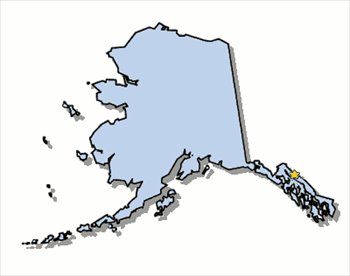Alaska Migration History 1900-2022
 Other state maps: California, Florida, Illinois, Texas, New York, Alabama, Arizona, Colorado, Utah, Virginia, Washington, all other states
Other state maps: California, Florida, Illinois, Texas, New York, Alabama, Arizona, Colorado, Utah, Virginia, Washington, all other states
by James Gregory
Alaska is the original migration state. Most scholars believe that humans first crossed from Asia into the American continents via the Berring land bridge to Alaska. Thousands of years later, the United States bought the region from Russia in 1867 without the knowledge or permission of the actual Alaskans. Three decades later in 1896, reports of gold in the Klondike region in Canada's Yukon triggered a rush of White Americans. The census of 1900 provides some data about the population and its origins, but these numbers are tricky because the Census Bureau used inconsistant and unreliable ways to count Indigenous Alaskans. That 1900 count registered about 29,000 Alaska Natives along with about 35,000 people born elsewhere, mostly the United States but also Sweden, China, Canada, and Great Britain.
The population grew little over the next forty years, indeed the census records a slight decline after 1910, but World War II brought military installations and defense industries that reshaped the economy. Our data are unreliable for 1940 and 1950, but the growth was very apparent in 1960, the first census taken after statehood. The population of 226,000 was now overwhelming White and from lower 48 states, especially the West Coast. The 1960 census counted less than 10,000 Alaska Natives but that was clearly an undercount. In 1970, the Indigenous Alaskan population reached 46,000 and increased steadily in the decades that followed.
Fishing and the US military were the mainstays of the Alaska economy until the discovery of a vast oil field under Prudhoe Bay in 1968. Oil industry migration brought substantial population increases in the remaining decades of the 20th century but has slowed as the oil boom faded. The demography of migration in the last half century has largely mirrored earlier patterns: mostly whites from the same states that had been sending migrants all along. But since 1980, migration has also brought a measure of diversity. Asians (particularly Filipinos) and Pacific Islanders now comprise about eight percent of the population. Latinos, most of whom have come north from California or Texas, account for another eight percent.
Today and for the last 120 years, Alaska depends upon migration for most of its population growth. Notice in the visualization below that the dark blue rectangle representing population born in Alaska remains smaller than the total of those born out of state. The 2022 numbers show that close to 60 percent of Alaskans are migrants from other states and countries. The percentage of adults born out of state would be higher still. Alaska also loses residents to outmigration. As the fourth tab shows, more than half of all persons born in Alaska have left. This visualization tool is hosted by Tableau Public and may take a few seconds to respond. If slow, refresh the page. Click here for other state migration histories
Move between four visualizations with tabs below
Note on data issues: Birth state information is missing for about 5% of US-born persons in 1970 and about 2% in 1960. These birthplaces are labeled "United States, ns" in the charts. Birthplaces were not recorded for enslaved persons in the 1850 and 1860 censuses, so it is not until 1870 that reliable data on African Americans became available. Native Americans were not routinely included in decennial censuses until 1900.
Source: U.S. Census data from the Minnesota Population Center's IPUMS USA: Steven Ruggles, Katie Genadek, Ronald Goeken, Josiah Grover, and Matthew Sobek. Integrated Public Use Microdata Series: Version 6.0 [Machine-readable database]. Minneapolis: University of Minnesota, 2015, the following samples: 1850 1%, 1860 1%, 1870 1%, 1880 1% 1900 1%, 1910 1%, 1920 1%, 1930 1%, 1940 1%, 1950 1%, 1960 5%, 1970 1% State FM1, 1980 5% State, 1990 5% State, 2000 1%, 2010 ACS, 2022 ACS.
Maps and calculations: James Gregory.

 Other state maps:
Other state maps: